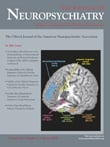Neuroleptic Induced Laryngo-Pharyngeal Dystonia
To the Editor: Acute laryngeal dystonia is a medical emergency requiring life saving interventions. It may explain at least some of the cases of sudden death of patients on neuroleptics. 1 We report a case of laryngeal dystonia which, although it posed diagnostic difficulties, was diagnosed early enough to save the patient.
Case Report
A 25-year-old man presented to the emergency room in altered sensorium, generalized rigidity, tremors, difficulty in swallowing, and respiratory distress of 2 days’ duration. There was no history of fever, vomiting, or headache. He had been diagnosed with paranoid schizophrenia in a peripheral hospital and had been on tablet haloperidol, 10 mg/day, for 2 weeks. He was afebrile, drowsy, and tachypnoeic with labored breathing. His vitals were stable with an oxygen saturation of 89%. Crepitations were heard in the left lung base with no focal neurological or meningeal signs. Complete hemogram, renal function tests, serum creatinine phosphokinase, and the hepatic function tests were within normal limits. Chest X-ray revealed left lower zone consolidation. Arterial blood gas analysis showed evidence of uncompensated respiratory acidosis with a CO 2 level of 87.5 mmHg. CSF examination and contrast enhanced CT scan of the brain were normal. Because of altered sensorium, CO 2 retention, and decreasing arterial oxygen saturation, elective intubation and mechanical ventilation were initiated. The intubation was difficult and achieved with 6.5 F cuffed tube, after three failed attempts.
Because of the rigidity, altered sensorium, and history of recent initiation of antipsychotic treatment, the possibility of neuroleptic malignant syndrome with aspiration pneumonia was considered. The absence of hyperthermia, diaphoresis, and autonomic dysfunction and normal serum creatinine phosphokinase levels made the possibility of neuroleptic malignant syndrome unlikely. He received intravenous promethazine, 50 mg injection, on the day of admission; haloperidol was discontinued and he was started on broad-spectrum antibiotics and trihexyphenidyl, 4 mg. Within 2 days, his rigidity and tremors reduced remarkably and he was weaned off the ventilator and extubated. Laryngoscopy revealed moderately adducted vocal cords with no evidence of edema. The difficult intubation, adducted vocal cords with absence of edema, tachypnoea and poor saturation suggested an upper airway pathology, and a diagnosis of laryngeal dystonia secondary to haloperidol was made retrospectively. He was discharged after a few days and is currently on regular follow up visits.
Comment
The diagnosis of laryngeal dystonia is often made retrospectively based on circumstantial evidence. 1 , 2 The advent of second generation antipsychotics has made laryngeal dystonia rare and the new generation of psychiatrists is unfamiliar with the entity. Any patient with history of psychiatric illness presenting with breathlessness should have laryngeal dystonia as a differential diagnosis, even when the treatment details are not known. A young male on high potency antipsychotics, with comorbid medical illness and substance use, is included in the risk factors for acute laryngeal dystonia. 1 , 2 The treatment with anticholinergics usually suffices, with change of medication to low potency antipsychotics. 3 Early identification of the laryngeal dystonia can be life saving and all psychiatrists and emergency personnel should be familiar with the symptoms and treatment of laryngeal dystonia.
1 . Christodoulou C, Kalaitzi C: Antipsychotic drug-induced acute laryngeal dystonia: two case reports and a mini review. J Psychopharmacol 2005; 19:307–311Google Scholar
2 . Vogler CM, Szonyli G: Laryngeal dystonia secondary to neuroleptic medications. Med J Aust 2001; 175:444–445Google Scholar
3 . Chakraborty A: Neuroleptic-induced acute laryngeal dystonia causing stridor: a lesson to remember. Mov Disord 2005; 20:1082–1083Google Scholar



